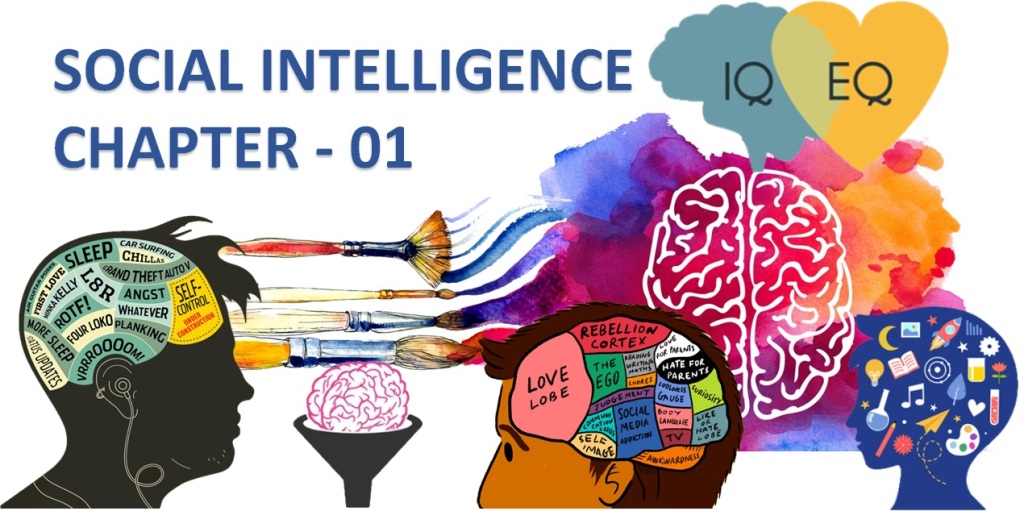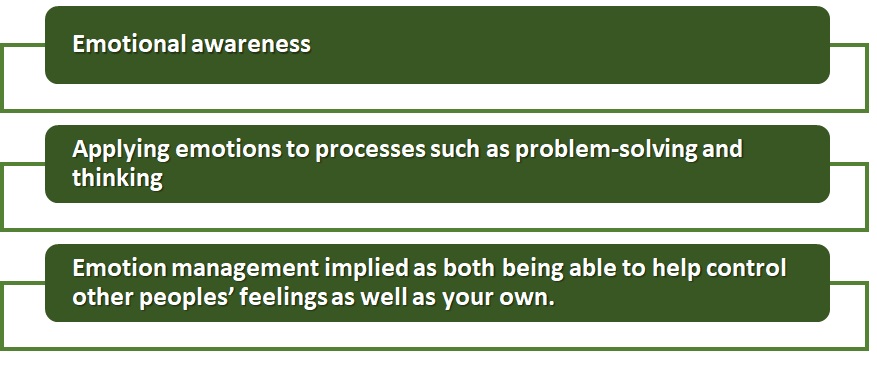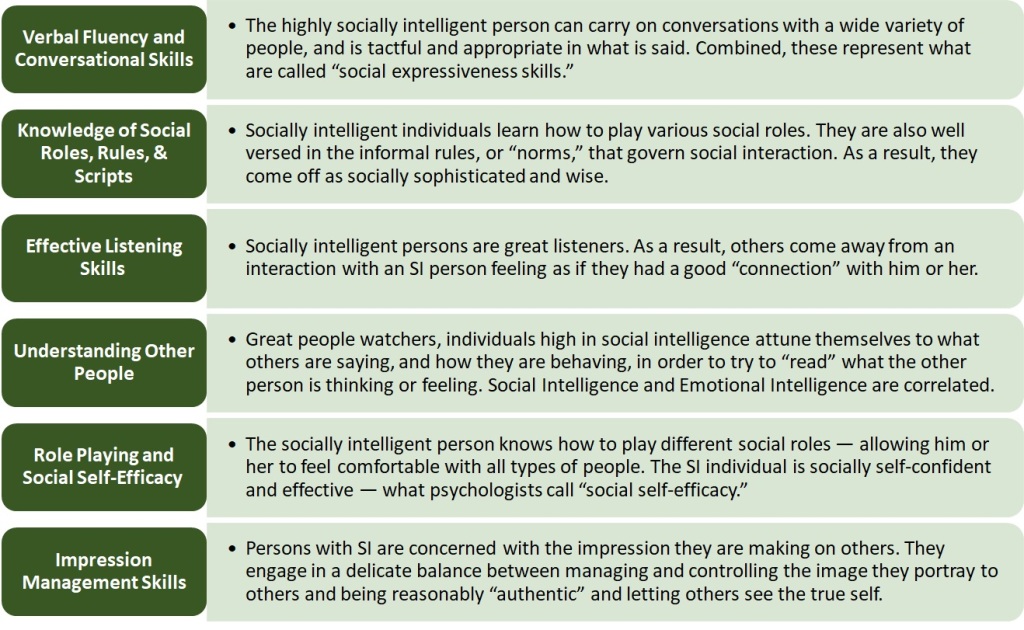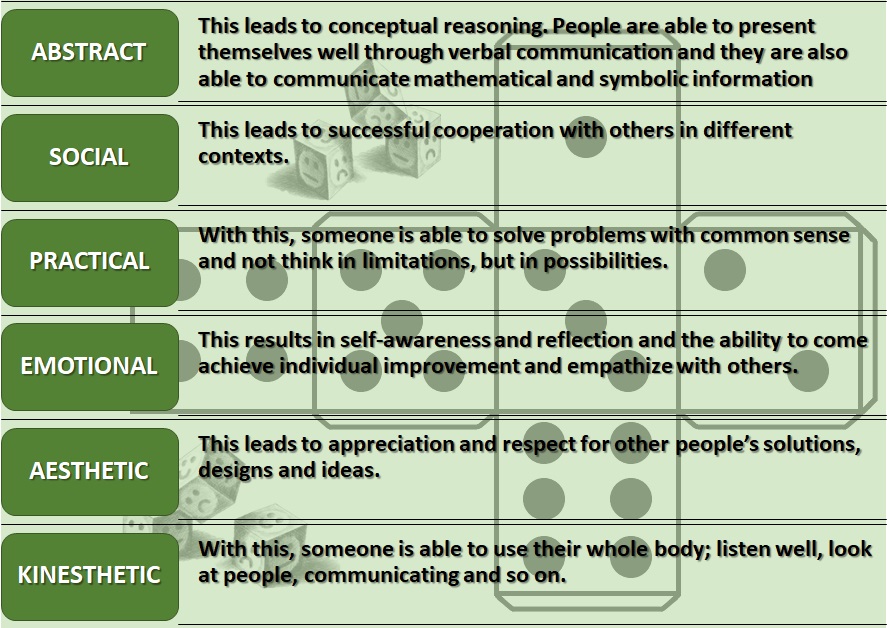– CHAPTER 02

***Continued from Chapter 01 (Covered previously: Intelligence & its meaning, Emotional & Social Intelligence, Social Intelligence at the Workplace, Social Intelligence & Nurturing Behaviours )
Link to Chapter 01:
Attributes that Aid in Building Social Intelligence
[01]:- The Proto-conversation: There is so much going on behind our words. As we speak, our brains are taking in micro-expressions, voice intonations, gestures and pheromones. People who have high SI have a greater awareness of their proto-conversations. This may be viewed under two aspects:
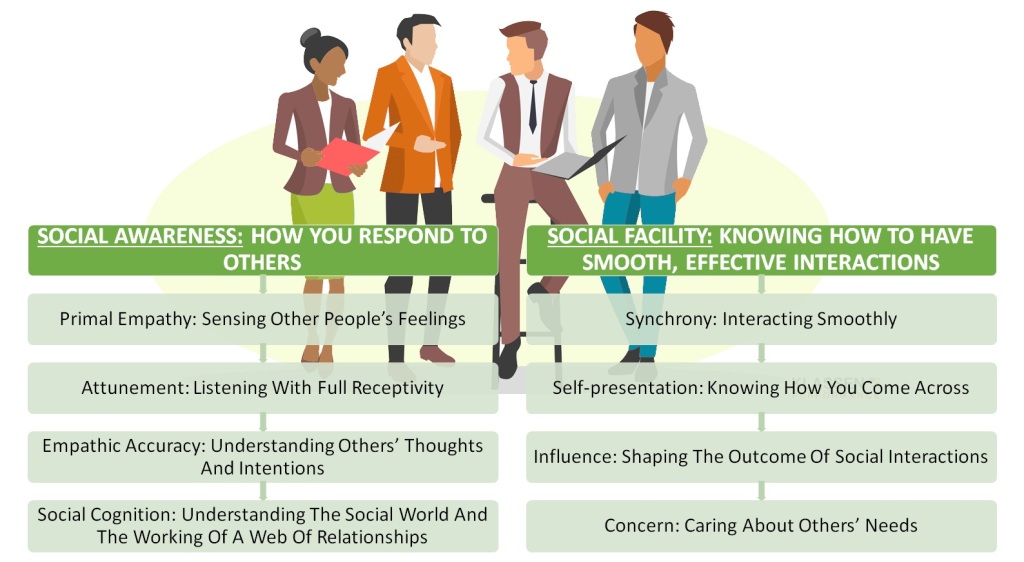
[02]:- Our Social Triggers: Let’s start with our social awareness. People and places trigger different emotions and this affects our ability to connect. Think about a time when we felt excited and energized by an interaction. Now think of a time when we felt drained and defeated after an interaction. The theory on how our brain processes social interactions is:

Why are these important? The Low Road guides our gut feelings and instincts. For example, if people didn’t come to our birthday parties as a child, we might feel a pang of anxiety when thinking about our own birthday as an adult–even if we have plenty of friends who would attend. Our High Road tells that we are a grown up and things have changed, but our Low Road still gives a bit of social anxiety. These may be referred to as social triggers. We will benefit by being aware of our unconscious social triggers to help make relationship decisions. Knowing our Low Road social triggers helps our High Road function. We can explore ours with the aid of a few questions-

[03]:- Our Secure Base: Whether we are a cheerful extrovert or a quiet introvert, everyone needs space and a place to recharge. A “secure base” is a place, ritual or activity that helps us process emotions and occurrences. A secure base is helpful for two main reasons. First, it gives us a place to recharge before interactions so we don’t get burnt out. Second, it helps us process and learn from each social encounter. After a business pitch, coffee meeting, party, or date do we set aside time to reflect and review what went right and wrong? Some questions we can explore during these post-mortems may be:
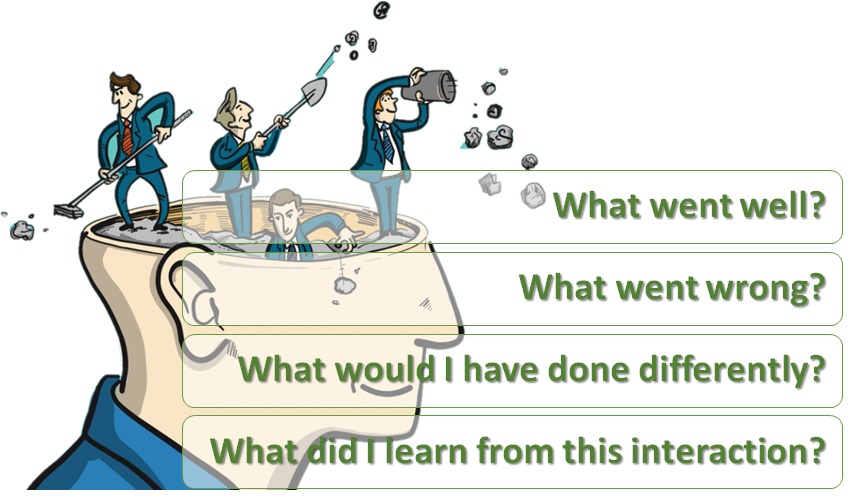
Possible secure base examples, on where we can do our post-mortem, may include in the car while driving home, journaling before bed, business workbook for ideas, brainstorming with a partner, or re-hashing with a friend.
[04]:- Broken Bonds: One of the biggest pitfalls in social intelligence is a lack of empathy. These may be referred to as Broken Bonds. It happens when one person treats another like an object as opposed to a human being. Imagine having just lost a family member. We get a phone call from a friend offering condolences. Immediately we sense the obligation of the caller. They are distracted, we can hear the typing of keys in the background. Their wishes are cold, memorized, and insincere. The call makes us feel worse not better. This interaction makes us feel like an ‘it’ –a to do list item, a ‘should,’ an obligation.
Don’t interact because we feel that we ‘should.’ Say no to obligations if you can. Interact with empathy or don’t interact at all.
[05]:- Adopt to Adapt: Our Low Road automatically mirrors the people around us. This is how empathy works. Our brain copies the people around us so we feel as they feel. This in turn helps us understand them, where they are coming from and even be better at predicting their reactions. Many paths of the low road run through mirror neurons. The neurons activate in a person based on something that is experienced by another person in the same way is experienced by the person himself. Whether pain (or pleasure) is anticipated or seen in another, the same neuron is activated.
Sometimes our High Road gets in the way. For example, if our partner is angry at something we try to stay calm. Then we try to calm them down. Usually this makes it worse. The upset person feels that we ‘don’t really understand’ or we ‘don’t get them.’ Why? Because we are fighting our instinct to mirror their upset. Sometimes we may just let ourselves adopt their emotions. Put ourselves exactly where they are. This might give us a new glimpse into their perspective and helps them see that we are on the same page as them.
[06]:- Beware the Dark Triad: This is the narcissistic personality, the Machiavellian personality and the psychopath or antisocial personality in people.

For example, if we were to ask the three, “who has the darkest personality?” The Narcissist would say “me”, the Psychopath would say, “I don’t care” and the Machiavellian would say “it’s whoever I want it to be”.
People scoring high on the 3 traits are more likely to commit crimes, and create severe social problems in society, families, and organizations.
[07]:- Mind-blind: This is the inability to sense what is happening in the mind of someone else. The key to mindsight is compassion.
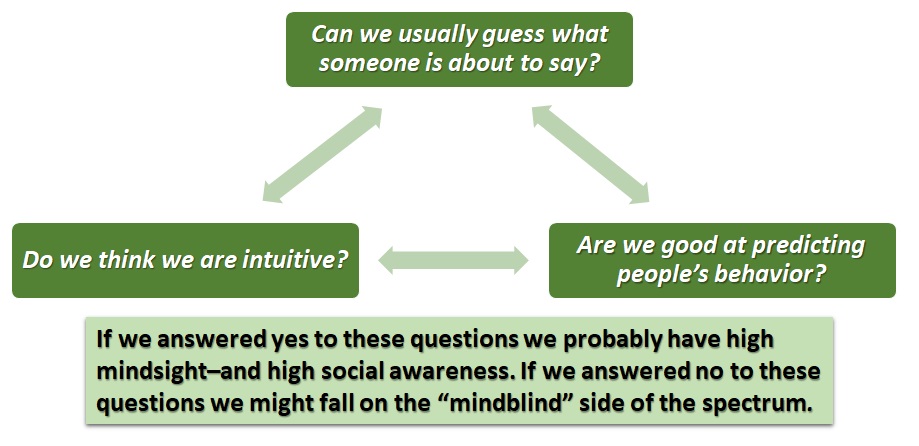
In short, self-absorption in all its forms kills empathy, let alone compassion. When we focus on ourselves, our world contracts as our problems and preoccupations loom large. But when we focus on others, our world expands. Our own problems drift to the periphery of the mind and so seem smaller, and we increase our capacity for connection – or compassionate action. We are wired for altruism. We are inherently good. However, sometimes we forget how good it makes us feel to be good.
[08]:- A People Prescription: The most striking finding on relationships and physical health is that socially integrated people, those who are married, have close family and friends, belong to social and religious groups, and participate widely in these networks, recover more quickly from disease and live longer. Roughly eighteen studies show a strong connection between social connectivity and mortality. One prescription for a long, healthy happy life can be positive relationships. Our partner, our friends, our colleagues our kids, they support our soul as well as our immune system. Investing in our relationships is worth the effort.
Social Intelligence Profile (SIP)
Social intelligence is measurable. It includes identifying important interaction skills and then assessing their behavior. Human interactions take place in specific contexts. SI is about someone being able to distinguish these situations and contexts from each other and react to them differently and behave accordingly. The different observable behaviors are the indicators of SI. This results in a Social Intelligence Profile (SIP). An SIP analyses social intelligence through different perspectives, with each observing the social interaction from a certain perspective.
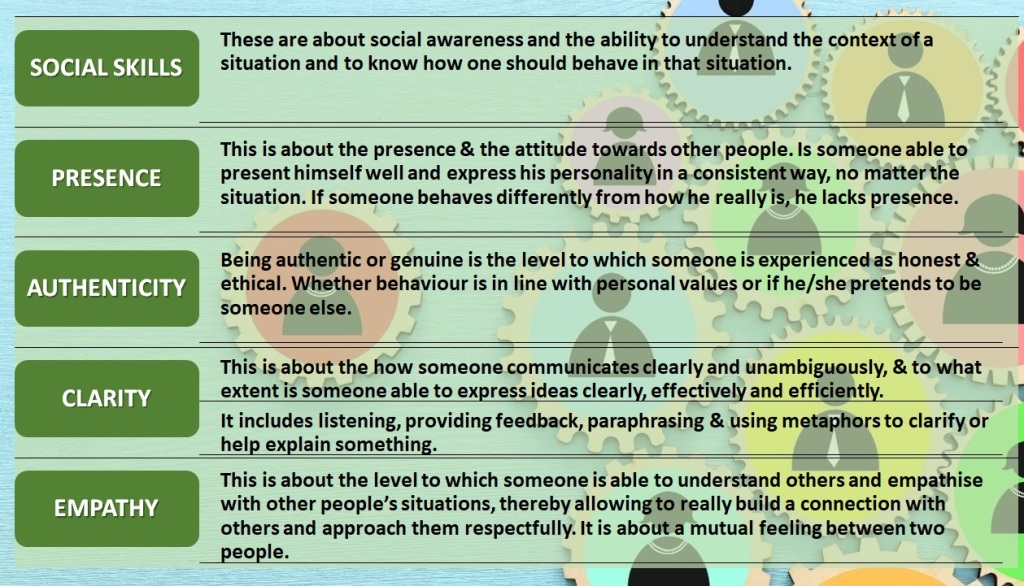
A person filling out the Social Intelligence Profile for self-evaluation will answer a range of questions that relate to the different behaviors. Each category has five scores, varying from little to a lot. The higher the scores, the higher the level of Social Intelligence. It should be noted that social intelligence only applies if there is an even distribution across the five basic skill categories. If one category is missing or if the score is particularly low, it is a good idea to focus on this area and practice with it.
Fostering Social Intelligence
It is a cliché to say that ‘we humans are social animals’, and yet we know that there can never be a statement more important than this one for deriving maximum happiness, success and significance out of one’s life. While some people may seem to develop social intelligence without really trying, others have to work to develop it. These tactics can help build social intelligence:
Pay close attention to what (and who) is around us. Socially intelligent people are observant and pay attention to subtle social cues from those around them. If someone in our life has strong people skills, watch how they interact with others. Keep track of how we are feeling. Awareness is an integral part of social intelligence. A good way to start is by being aware of our own physiological cues to our emotional state like heartbeat, respiration, perspiration etc. It will help gauge our internal dynamics and will help offset reactions and manage impulse.
Work on increasing our emotional intelligence. Although similar to social intelligence, emotional intelligence is more about how we control our own emotions and how we empathize with others. It requires recognizing when we are experiencing an emotion—which will help recognize that emotion in others—and regulating them appropriately. An emotionally intelligent person can recognize and control negative feelings, such as frustration or anger, when in a social setting.
Respect cultural differences. Also, seek out cultural differences so we can understand them. Although most people learn people skills from their family, friends and the community surrounding them, a socially intelligent person understands that others might have different responses and customs based on their upbringing.
Practice active listening. Taking time to think about what someone else is saying before we respond, and, listening to the inflections in what others say, will give us clues to what they really mean.
Appreciate the important people in our life. Socially intelligent people have deep relationships with people who are meaningful to them. Pay attention to the emotions of our spouse and children, friends, co-workers, and other peers. If we ignore the closest people in our life, we will miss the cues on how to connect with them.
Approach interpersonal interactions with receptiveness. Whenever we have an opportunity for interpersonal interactions – a meeting, a discussion, a one-on-one, a conversation – try to get into it without preconceived notions. People are not events, they are processes. And it is only our mind’s typecasting that stops us from looking at them anew.
Make an effort to put ourselves in other person’s shoes. While dealing with someone, try to actively imagine other person’s intervening aspects like situations, constraints, preferences, complexes, priorities, or aspirations. And do it so that we can know where he or she is coming from and not to conclude how he or she is.
Reading invisible interconnections in a social apparatus. Some people call it politics and some others name it diplomacy, but the fact remains that every place, organization, institution, event or occasion has an invisible hierarchy and power-dynamics to it. Everyone is connected to everyone else in a unique way. It is important to understand these subtle interconnections at play. This helps in managing our responses wisely.
Learn to interpret people’s non-verbal behavior. Emotions call shots in most situations. And the fact is that nonverbal behavior – gestures, postures and expressions – is the most trustworthy representation of one’s emotions. Thus, to develop social intelligence, it is crucial to learn the skill of interpreting non-verbal behavior.
People who are socially intelligent display core traits that help them communicate and connect with others.

Social intelligence is a critical skill for success and well-being in today’s interconnected world. By understanding the key concepts and skills of social intelligence, and by practicing and developing these skills in our lives, we can improve our relationships, enhance our job performance, and experience greater levels of well-being and life satisfaction. Whether we are interacting with colleagues, friends, or family members, developing our social intelligence can help us navigate social situations with greater ease and effectiveness.

Content Curated By: Dr Shoury Kuttappa


